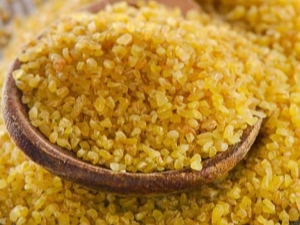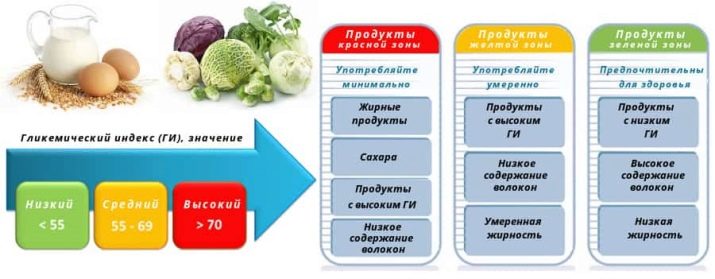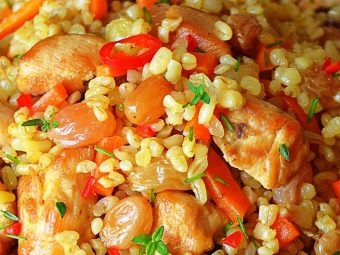Bulgur in diabetes: properties, glycemic index and rules of use

Bulgur appeared on the market and began to enter the menu of average consumers relatively recently. Until now, even in large cities, croup is perceived as a wonder and is not in great demand. Its main consumers today are people with type 2 diabetes and those who want to lose weight. However, Bulgur has a number of significant advantages over traditional, more familiar cereals. This contributes to its promotion in a wider range of consumers.
This article discusses the main points related to the use of cereals and how to include it in the daily diet.
Origin and features
Bulgur came to Central and Eastern Europe from the East and the Mediterranean, where it has been known for more than 4 thousand years as an indispensable ingredient of many dishes. Different nations, he had a different name (Bulgore, Burgul, Hurgul). Bulgur is a wheat grain.
The croup is obtained by treating the grains with steam and then drying them under the sun. At the last stage, the grain is sent to crushers, from which, depending on the size of the fraction, either large Plavlik used in side dishes and pilaf, or koftelik (finely ground grain added to dolma or salads) are obtained. A specific feature of bulgur can be considered heat treatment before crushing. This ultimately leads to the fact that boiled bulgur is crumbly, in contrast to couscous or semolina.
Bulgur surpasses most grains in the presence of vitamins and minerals in the composition, as well as in saturation with slow carbohydrates. For example, semolina and wheat flour are predominantly saturated with fast carbohydrates.
Glycemic index
The glycemic index is the ratio of the amount of carbohydrates in the body to the amplitude of the increase in blood sugar, following the ingestion of food. For ease of use of this indicator, a scale was developed from 0 to 100, where the maximum value corresponds to pure glucose.
People eager to eat right, try to choose foods with a low (0-15) or medium (16-50) glycemic index.
The hypoglycemic index of this product is low, so it can be used by diabetics.
To calculate the glycemic index, use the volume of the product, which will contain 50 g of carbohydrates. Also calculate the glycemic load. This is a value that takes into account in the calculation not only the source itself, but also its quantity.
The formula for calculating the glycemic load is: GN = (content of pure carbohydrate per 100 g) / 100 * GI. The higher the glycemic load, the stronger the insulinogenetic effect of the dish.
The glycemic index of croup depends on several factors:
- primary processing method;
- fraction values after grinding;
- processing method when cooking;
- recipes ready meals.
The glycemic index of the finished dish may differ significantly from the index of the original product. For example, GI of oatmeal on milk will be higher than that of dry oatmeal, or porridge cooked in water.
GI Bulgur (even pre-fried) - less than 45. The index of the product boiled in water is 35 units. In addition, it is worth considering that, despite the high caloric content in a dry form (more than 340 kcal), only 100 kcal is consumed per hundred gram portion of boiled bulgur.
Use in case of diabetes mellitus type 2
Diabetes is a serious disease that requires long-term treatment and a strict diet. The ration of a person with such a diagnosis almost always includes cereals, but with this disease, it is necessary not only to choose foods with the lowest sugar content, but also to take into account the caloric and glycemic index. A sharp rise in blood sugar levels causes hyperglycemia, which leads to an increased load on the internal organs, which can cause their damage.
Products with high GI should be used with great care. You need to cook them only by boiling them in water without adding sugars or fats. In this case, the inclusion of such products in the diet in any case should be coordinated with your doctor. Products with an average GI value may be included in the patient's diet, but their quantity must be determined by the doctor and strictly observed in order to avoid complications and deterioration of health.
Safe foods are considered to have a glycemic index of no more than 40 units. Cereals with a similar GI value can be consumed with almost no restrictions, since the jump in blood sugar after their use is minimal.
The glycemic index of bulgur is slightly below the middle boundary. It should be used with type 2 diabetes with some caution. However, bulgur quickly gives a feeling of saturation, and eating a lot of it, despite its pleasant taste, is very difficult.
To reduce the risks, bulgur should be processed by boiling on water, without prior roasting. You should not combine it with fatty ingredients and foods high in sugars.
The dish is recommended to be consumed in small portions throughout the day in order to maintain a feeling of fullness and combat overeating.
Contraindications and recommendations
Like any food product, bulgur can be both recommended for use and contraindicated in certain circumstances. To the positive sides of the Bulgur it is worth mentioning a few points.
- Due to the presence of folic acid and the content of vitamin B6, it helps to stabilize the performance of the heart muscle and strengthen the blood vessels, reducing the risk of heart attack and stroke.
- A high content of fiber is the prevention of oncological diseases of the esophagus, gastrointestinal tract and mammary gland.
- The presence of plant fibers prevents stone formation and the overall reduction in liver workload. In addition, the fibers have a positive effect on the digestive system as a whole, which improves glucose regulation and enhances the effectiveness of insulin in the treatment of diabetes.
- The product helps to compensate for the deficiency of magnesium, phosphorus, sodium, iron and other trace elements in the body.
- The presence of betaine and folic acid in bulgur is an excellent prevention of the appearance of anemia, disorders of the nervous system and the musculoskeletal system. It also prevents the onset of osteoporosis and Alzheimer's disease.
- A high concentration of copper prevents such troubles as apathy, anemia, and previous hair bleaching.
- Prolonged processing of the product by the body helps to reduce feelings of hunger, reduce the number of meals and the total caloric intake. It helps in the fight against excess weight and overeating.
- A large amount of fiber helps to speed up the metabolism and detoxify the body. Rapid rehabilitation of the body after intense loads provides a high caloric content of the product.
Contraindications to the use of bulgur include the presence in the composition of gluten, which is a strong allergen. People with the problem of digestibility of gluten-containing foods are threatened with impaired digestion, general weakness. Do not eat bulgur for ulcers, gastritis and other inflammatory diseases of the gastrointestinal tract. It is not recommended to combine bulgur with cabbage, potatoes or eggs in one recipe. This combination can cause flatulence.
The combination of cooking
Bulgur is a universal product. It can be present as an ingredient in a variety of dishes. It is able to act as a substitute for rice, couscous, pearl barley. Traditionally, in Mediterranean cuisine, from where Bulgur came to the European market, it is pre-fried with a small amount of olive or other vegetable oil to impart a nutty flavor and a more complete disclosure of taste.However, when dieting such a method is better to exclude to reduce the glycemic index of the finished dish.
Bulgur can also be used as a side dish, just boiled it. The ratio of water and cereal in this case should be 3: 1. For the preparation does not require a large amount of salt or sugar, which improves the digestibility of the dish and does not harm the body. Porridge turns out crumbly, which makes it possible to use it for making cutlets, meatballs, stuffed peppers and zucchini. It can also be added to soups or used as a substitute for rice in the pilaf.
Bulgur is combined with meat products, including turkey, fish, seafood and beef. It is an excellent ingredient for salads, combining with any kinds of vegetables and root crops, well emphasizes the taste of spices. Bulgur can also be combined with honey, nuts and dried fruits.
To reduce weight, preferably a combination of cereals with beans, peas, zucchini or eggplants. The inclusion of Bulgur in dishes with salty cheeses will help get rid of excess salt and will give the opportunity to better feel the taste of the main ingredients. In addition, sometimes Bulgur can be a constituent element of desserts such as sweets, fruit salads or pastries (for example, as a filler for pies).
In conclusion, we can say that bulgur, even not being a widely used product, has already occupied a worthy place in the diet of many people. Its use is not limited to medical and prophylactic diets. The use of this product will benefit almost anyone, as it has a positive effect on the health and health of the body as a whole.
How to get rid of diabetes with the help of bulgur, see the next video.






























